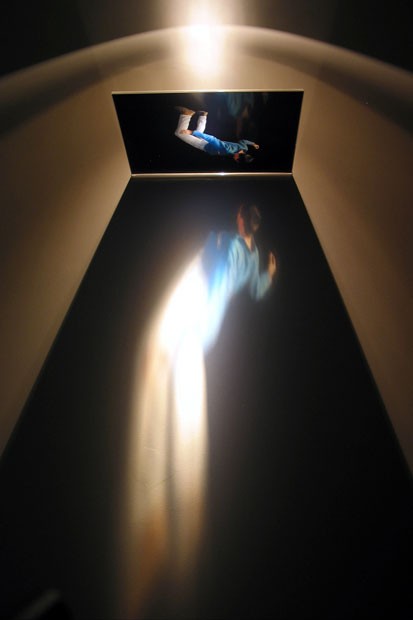artefact
In his article, Frank Chimero refers to the digital screen as being in a state of flux (having the ability to change). He considered Eadweard Muybridge’s zoopraxiscope as a precursor of screens and screen practice because of its ability to use light and image to reanimate still photographs. Since this invention, we have seen a plethora of electronic and digital methods for lighting and displaying images on surfaces. If we perceive these technologies to offer renderings of change, all screens become a combination of three elements: colour, light and movement in time.
Precedent
Daniel Canogar is a Spanish artist who works with new and old technologies. His work Icaro references the old Greek legend of the same name and recreates the fall. The photographs are printed on duraclear film and adhere to a plexiglass shelf that is mounted perpendicular to a wall. A spotlight shines down from above, casting a shadow of image against the wall. This setup is a projector in which the image does not move.
Other projectors
Magic lantern and film slide projectors are analogue technologies that also shine light through images. In magic lantern performances, the entertainer changes the slides and adds exciting commentary to build the narrative. Film slide projectors present a slideshow of static images which can illicit oral explanation or dialogue. While the images are static in both projectors, the passage of time and change is driven by human manipulation-verbal story telling, interchanging the slides.
The digital screens we see today are also projectors but the images they show are dynamic and have the ability to change automatically.

Method
Choice of Images
Reflecting on feedback from the previous experiments thus far, I chose images that were from my phone’s camera roll. In this case I choose landscapes which I thought provided a good cross section of neutrality but something that we all see and have a photo of in our phone. By choosing an image, instead of drawing directly on the plastic for example, I can reimagine images and our relationship to them.
Printing the images
The first attempt for printing the images did not go too well. The pictures I had chosen were too light and transparent that the shadow cast was weak. For the next round of printing, I increased the contrast and saturation significantly. The resulting shadows were rich and colourful. I used double sided tape to adhere the film to acrylic.
![Increasing saturation is important for lighter colours]()

Results
I tested this experiment during the day (using natural light) and the night (using a torch). The natural light created a warm inviting tone, while during the night, the projections conjured a mysterious tone. There is more control over the intensity, angle and position of the light during the night.
Day
Because there is more light, you can see both the shadow and the film. 
The flexibility of the film can create an illusion of peeling something off.

____
Night


